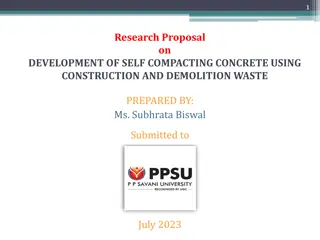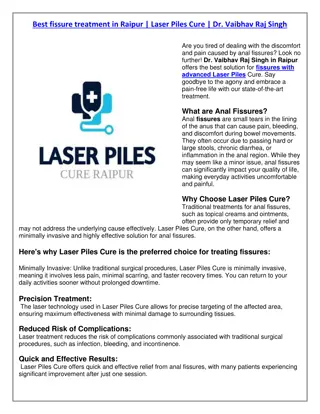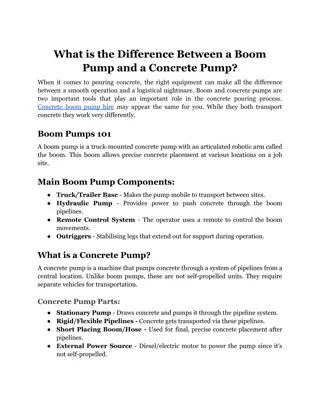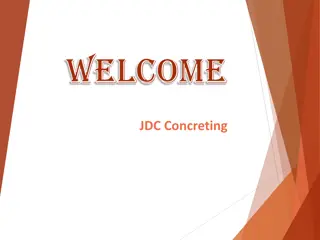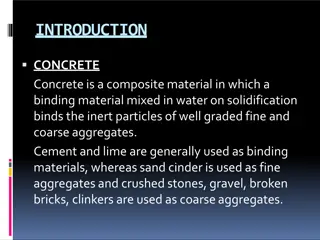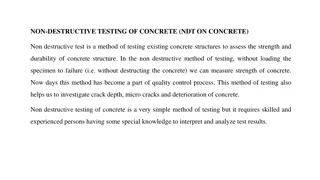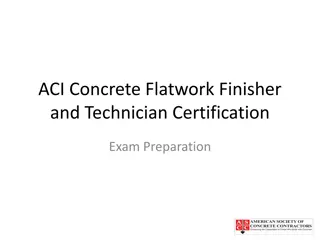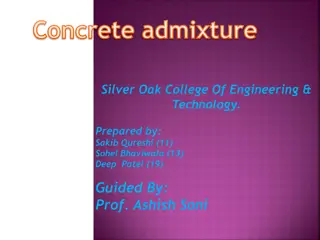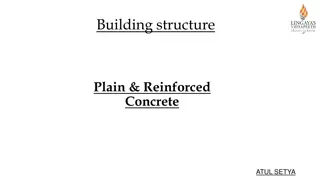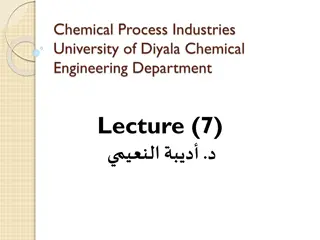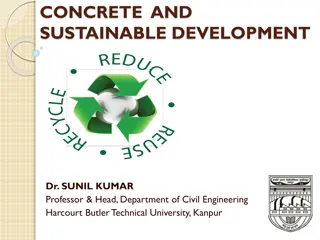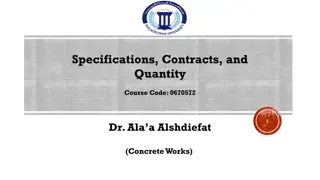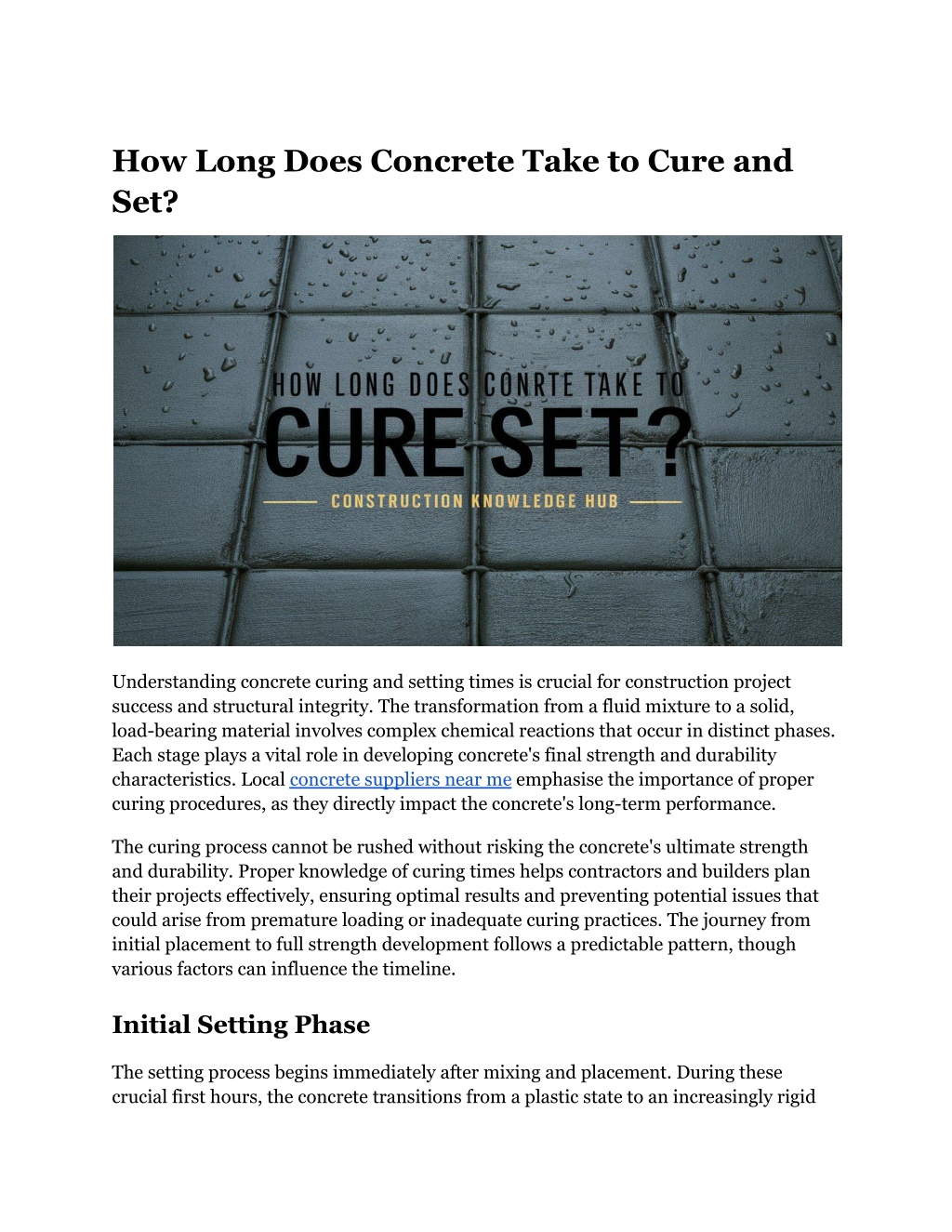
How Long Does Concrete Take to Cure and Set
Discover the stages of concrete curing, from initial set to full strength, and learn how timing impacts durability and performance.
Download Presentation

Please find below an Image/Link to download the presentation.
The content on the website is provided AS IS for your information and personal use only. It may not be sold, licensed, or shared on other websites without obtaining consent from the author. Download presentation by click this link. If you encounter any issues during the download, it is possible that the publisher has removed the file from their server.
E N D
Presentation Transcript
How Long Does Concrete Take to Cure and Set? Understanding concrete curing and setting times is crucial for construction project success and structural integrity. The transformation from a fluid mixture to a solid, load-bearing material involves complex chemical reactions that occur in distinct phases. Each stage plays a vital role in developing concrete's final strength and durability characteristics. Local concrete suppliers near me emphasise the importance of proper curing procedures, as they directly impact the concrete's long-term performance. The curing process cannot be rushed without risking the concrete's ultimate strength and durability. Proper knowledge of curing times helps contractors and builders plan their projects effectively, ensuring optimal results and preventing potential issues that could arise from premature loading or inadequate curing practices. The journey from initial placement to full strength development follows a predictable pattern, though various factors can influence the timeline. Initial Setting Phase The setting process begins immediately after mixing and placement. During these crucial first hours, the concrete transitions from a plastic state to an increasingly rigid
material. It is recommended to complete all finishing operations during this window to achieve the desired surface characteristics. Some characteristics of initial setting are: Chemical Reactions: The cement particles begin hydrating, forming a crystalline structure that gives concrete its strength. This process generates heat and initiates the hardening process. Surface Changes: The concrete surface loses its sheen and begins to stiffen, marking the start of setting. This typically occurs within 2-4 hours after placement. Working Time: Finishers must complete their work before the initial set occurs, as disturbing the concrete after this point can compromise its strength. Final Setting and Early Strength The transition from initial to final set marks a critical period in concrete development. This phase typically spans 4-8 hours after placement, during which the concrete develops enough strength to support its own weight and light loads. During this period: Form Removal: Basic forms can usually be removed after 24-48 hours, though structural forms may require longer periods. Surface Protection: While the concrete can support foot traffic after 24-48 hours, it remains vulnerable to damage and requires continued protection. Early Strength Development: The concrete achieves approximately 70% of its design strength within the first week, enabling light vehicle traffic after seven days. Complete Curing Process While concrete reaches usable strength relatively quickly, the full curing process extends over a longer period. The industry-standard 28-day curing period represents the time typically required to achieve design strength, though strength development continues beyond this benchmark. Some curing considerations are: Moisture Maintenance: Keeping concrete moist during the first seven days is crucial for proper strength development. Temperature Control: Maintaining appropriate temperatures during curing helps ensure optimal strength gain.
Protection Measures: Shielding concrete from extreme weather conditions and premature loading prevents strength compromise. Moreover, advanced monitoring techniques during this period help ensure optimal strength development: Maturity Testing: Using embedded sensors to track temperature history and estimate strength development Non-Destructive Testing: Employing methods like ultrasonic pulse velocity to assess concrete strength Core Testing: Taking concrete core samples when required for strength verification Chemical Processes During Curing Implementing the chemical reactions during curing helps in managing the process effectively. Leading concrete suppliers near me suggest using these reactions for achieving desired concrete properties. The hydration process involves: Initial Reaction: Calcium silicates in cement react with water, forming calcium silicate hydrate gel Heat Generation: The exothermic reaction produces heat that influences curing rates Crystalline Formation: Development of a complex crystalline structure that provides concrete strength Environmental Factors and Curing Time Multiple environmental and mix-design factors influence curing time and final strength development: Temperature Effects: Warm temperatures accelerate the curing process but require careful moisture control Cold weather significantly slows strength development and may necessitate special curing procedures Extreme temperature variations can lead to cracking and other defects
Moisture Considerations: Adequate hydration throughout the curing period ensures proper strength development Insufficient moisture can lead to reduced strength and increased cracking Excessive water can weaken the concrete surface and delay setting Advanced Curing Technologies Modern construction employs sophisticated curing methods to optimise results: Automated Curing Systems: Computer-controlled environments maintain ideal temperature and humidity Infrared Monitoring: Remote temperature tracking ensures uniform curing Smart Sensors: Real-time data collection for curing condition verification Benefits include: More consistent results Reduced labour requirements Better documentation of curing conditions Common Curing Problems and Solutions Identifying and addressing curing issues promptly ensures better outcomes: Surface Issues: Crazing: Implement proper finishing techniques and moisture control Dusting: Avoid premature finishing and maintain adequate moisture Scaling: Protect against freeze-thaw cycles during curing Structural Concerns: Cracking: Monitor temperature differentials and moisture content Strength Variation: Ensure uniform curing conditions across the structure Delayed Setting: Adjust mix designs for environmental conditions Project Planning Around Curing Times Effective project management requires careful consideration of curing times:
Schedule Integration: Critical Path Analysis: Include realistic curing times in project schedules Weather Forecasting: Plan around optimal environmental conditions Resource Allocation: Schedule equipment and personnel efficiently Loading Sequence: Progressive Loading: Implement staged loading based on strength development Traffic Management: Control access during critical curing periods Equipment Placement: Schedule heavy equipment operations after adequate strength gain Specialised Applications and Considerations Different applications may require modified curing approaches: High-Strength Applications: May require extended curing periods and specialised curing methods Decorative Concrete: Often needs careful moisture control to prevent discoloration Industrial Floors: Typically demand strict adherence to curing protocols for wear resistance In A Nutshell Understanding concrete curing and setting times enables proper project planning and execution. Proper curing practices, beginning with selecting quality materials from reputable concrete suppliers and continuing through the entire curing period, determine the concrete's ultimate performance. The investment in proper curing practices pays dividends through enhanced durability, reduced maintenance requirements, and extended service life of the concrete structure. Site Article: How Long Does Concrete Take to Cure and Set?

